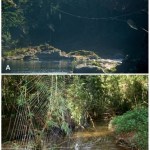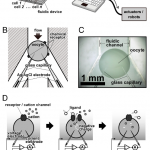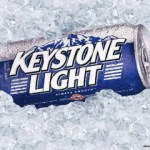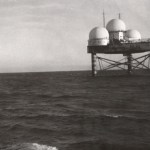engineering
This year's Grace Hopper Celebration of Women in Computing took place this past week in Atlanta, GA.
I thought I'd gather together some small part of the blog posts I've been seeing floating around the Internets on this wonderful event.
Opening Session of Grace Hopper Conference - 2010
Dancing with Hundreds of Technical Women at Grace Hopper
The Impact of the Grace Hopper Celebration
It's the most wonderful time of the year
Back from GHC10@tlanta, now time to retrospect
Together, We Are Big Fish!
Grace Hopper Celebration 2010 : Day 2 (29 September)
Open Source Codeathon for Humanity (a…
There was some big news yesterday in transgenic silk from Notre Dame and the University of Wyoming, where scientists have genetically engineered silkworms to produce silk that is a mixture of spider silk and the regular silkworm stuff. Silkworms produce the strong and versatile silk that is used to make clothes, but spiders produce silk that can be much stronger and much more elastic. Spiders, however, don't like to be grown in huge factories and don't make easily harvested cocoons like silkworms, so gathering even small amounts is very difficult (here's a fun how-to for collecting spider…
Having started my working life as a software developer, I know a bit about epic bugs. Let's just say I've had my share and leave it at that. At very least, I can say I never caused any vehicles to crash or any companies to fail.
So, from ComputerWorld, Epic failures: 11 infamous software bugs.
Instead, this story is about outright programming errors that caused key failures in their own right.
Have I missed anything important? Consider this a call for nominations for the biggest bugs of all time. These are my suggestions; if you have any honorable mentions, bring 'em on. The worst anyone…
Check out this great video from on of our partner orgnaizations Engineers.com. From the Science Festival to Mario Brothers and robots. Cool video! Thanks for the shout out!
A lot of synthetic biology is about getting biology to be more like electrical engineering, designing genetic "logic gates" to create a living circuit board. Beyond analogies, however, cells have many fascinating electrical properties--proteins that transfer electrons like wires, membranes that separate ions and create an electrical charge that drives the metabolism of the cell, channels through these membranes that open and close to activate an electro-biological response. Electrons are electrons whether they are in proteins or copper wires, and many scientists have designed ways to connect…
Some interesting articles, as usual, in the latest issue:
External Characteristics of Computer Operations: Toward Large Conversational Time-Sharing Systems by Wiehle, Hans Rudiger
First Edition Unix: Its Creation and Restoration by Toomey, Warren
The Network Information Center and its Archives by Feinler, Elizabeth
Promoting the Prosaic: The Case for Process-Control Computers by Aylen, Jonathan
There are also a few articles on the AEG-Telefunken TR 440 computer.
There's a terrific new article in New Scientist about some of the ways scientists are working on turning pee into energy. There's a lot of pee in the world all going to waste, often at huge cost to the environment in terms of energy used to collect and purify waste water. Methods that can produce even small amounts of power from urine could be useful to help power office buildings or farms where there are a lot of people or animals all peeing in the same place, and smaller fuel cells could even also be used to power portable electronics, with no need to carry any fuel or batteries, just a…
A recent survey of 3,000 people worldwide found what many have known all along--that Legos are the best toy ever made. For synthetic biologists, this doesn't come as much of a surprise--Legos are at the heart of the concepts underlying the basics of synthetic biology.
Legos are a favorite analogy for BioBricks, the DNA parts that are made to easily "snap" together using a shared genetic engineering strategy. The iGEM competition is structured around BioBricks, with undergraduate teams combining old and creating new BioBricks for the Registry of Standard Biological Parts, competing for the…
I actually read the freely downloadable version of Cory Doctorow's novel Makers on my Kobo ereader, even though I did buy the hardcover when it came out last year. Mostly, I wanted to check out the experience of reading a long text on my reader. Overall, the Kobo reading experience was terrific, not much different from reading a paper book. I tried it on both long inter-city bus rides and my regular commute as well as just sitting around the house. The Kobo is pretty bare bones, as these readers go, but it was good enough to consume fairly simple text. The Makers text was in epub format…
As a founder and organizer of the upcoming inaugural USA Science & Engineering Festival, I'm in frequent contact with a wide range of teachers, students, innovators, community leaders, entrepreneurs and decision makers in science and technology across the country.
One thing that I continue to learn from these experiences: There is a growing need out there, even a grassroots desire, among average Americans to understand and connect in meaningful ways with the vast array of science and technology impacting their lives today -- provided that this information is presented to them through…
As if Pepsigate wasn't enough to get people riled up, this could be even move apocalyptic!
H. Steven Wiley takes a close look at the real Two Cultures, Scientists vs. Engineers!
In the past, I have heard there was conflict between the "two cultures" of science and the humanities. I don't see a lot of evidence for that type of conflict today, mostly because my scientific friends all are big fans of the arts and literature. However, the two cultures that I do see a great deal of conflict between are those of science and engineering.
*snip*
At one extreme, you have basic scientists, who seek to…
Following up on my first post a while back, All aboard the York University Space Elevator!, the York University Earth and Space Science and Engineering research team of Raj Seth, Brendan Quine and George Zhu have published another paper, this time in The Journal of the British Interplanetary Society, Feasibility of 20 km Free-Standing Inflatable Space Tower. (Open Access version)
This paper describes the theory and analysis for the construction of a thin walled inflatable space tower of 20 km vertical extent in an equatorial location on Earth using gas pressure. The suborbital tower of 20 km…
First of all, the conference program is here. All the paper versions of the presentations will eventually be deposited in Queen's IR, QSpace, but don't seem to be there yet. I posted about my presentation here: Using a Blog to Engage Students in Literature Search Skills Sessions.
Now, If there can be said to be a theme to a conference which has no official theme, then the CEEA conference's theme was nicely summed up by a question from the audience during one of the sessions:
"How do you teach humbleness?"
Again and again it came up -- the challenge of teaching young, confident and…
Last week I was at the Canadian Engineering Education Association Inaugural Conference in Kingston. It was a great conference and a very auspicious beginning for this very new organization. I have a summary post in the works which I hope to have up fairly soon.
I presented the above titled paper on Monday afternoon, June 7th. It went pretty well -- I was part of a session with a couple of other librarian presentations so it was mostly just us librarians. However, there were several faculty members present and I did get a couple of nice comments about the presentation later on in the…
Another terrific issue. I'm going to list everything but the book & database reviews & reports so as not to clutter the post too much.
Five Voices, Two Perspectives: Integrating Student Librarians into a Science and Engineering Library by Eugene Barsky, Aleteia Greenwood, Samantha Sinanan, Lindsay Tripp, and Lindsay Willson, University of British Columbia
Collection Assessment in Response to Changing Curricula: An Analysis of the Biotechnology Resources at the University of Colorado at Boulder by Gabrielle Wiersma, University of Colorado at Boulder
Browsing of E-Journals by…
Spinning off a blog at Inside Higher Ed, the Dean Dad has a post on deciding what classes are essential:
My personal sense of it is that the distinction between core and periphery is largely a function of purpose. If your goal in life is to be an exhibited artist, then you might well decide that art is essential and history a frill. If your goal is to be an engineer, I could understand valuing a math class over a psych class. Since different students have different purposes, I wouldn't be surprised to discover that one student's frill is another student's priority.
But the questions go deeper…
I have a few conferences coming up and I thought I'd share my schedule just in case any of you out there in sciencelibrarianblogland will also be attending.
I'll list them in order, along with whatever I'll be presenting.
BookCamp Toronto, May 15, Toronto
9:30: eBooks in Education and Academia -- the glacial revolution
John Dupuis (York University)
Evan Leibovitch (York University)
Description: Despite growing public acceptance of eBooks, two areas in which they could offer the most benefit -- education and academia -- are far behind the eBook mainstream. This session will discuss issues…
Ah, The Onion. A true repository of snark and snideitude
But as the winter lingered, Spirit began producing thousands of pages of sometimes rambling and dubious data, ranging from complaints that the Martian surface was made up almost entirely of the same basalt, to long-winded rants questioning the exorbitant cost and scientific relevance of the mission.
Project leaders receive data from the Mars rover Spirit.
"Granted, Spirit has been extraordinarily useful to our work," Callas said. "Last week, however, we received three straight days of images of the same rock with the message 'HAPPY NOW…
That's the title of the short article I have in our most recent York Libraries Faculty Newsletter. It's a rejigged version for faculty of the two posts I did a while back on the blog I use for IL sessions, here and here. I'll be doing a more formal report on the IL blog at an upcoming conference, but that's for another post.
A lot of the newsletter is of local interest only, but there are a couple of articles that will have a broader appeal:
Information Literacy and Peer Tutors in the Classroom
Research Study on Perceptions of IL
It's also worth pointing out the short profile of Toni…
On January 15, 1961, the US coastguard raced through the darkness toward a tiny point 84 miles southeast of New York City. There, 28 crew members of Texas Tower 4 were waiting desperately to be evacuated from their station. As huge swells and high winds pounded the hull of the ship, their radios picked up a frantic transmission from the tower: "We're breaking up". And with that, Texas Tower 4 and all of its occupants were pulled beneath the waves.
Built in 1957, the five Texas Towers were intended to become part of the USA's advanced early warning system against Soviet bombers. Named for…




